Efficiency Enhancement of Perovskite Solar Cells with Plasmonic Nanoparticles: A Simulation Study
Abstract
:1. Introduction
2. Literature Background
3. Simulation Procedure
4. Results & Discussions
4.1. Plasmonic Resonances of Au and Ag NPs
4.2. Impact of Ag NPs on Perovskite Cells
4.3. Impact of Ag NPs on Perovskite Cells
4.4. Comparison Between Gold and Silver Effects
5. Outlook
6. Conclusions
Author Contributions
Funding
Acknowledgments
Conflicts of Interest
References
- Kojima, A.; Teshima, K.; Shirai, Y.; Miyasaka, T. Organometal Halide Perovskites as Visible-Light Sensitizers for Photovoltaic Cells. J. Am. Chem. Soc. 2009, 131, 6050–6051. [Google Scholar] [CrossRef] [PubMed]
- Contreras, M.A.; Mansfield, L.M.; Egaas, B.; Li, J.; Romero, M.; Noufi, R.; Rudiger-voigt, E.; Mannstadt, W. Wide bandgap Cu(In,Ga)Se2 solar cells with improved energy conversion efficiency. Prog. Photovolt. Res. Appl. 2007, 15, 659. [Google Scholar]
- Burschka, J.; Pellet, N.; Moon, S.; Humphry-Baker, R.; Gao, P.; Nazeeruddin, M.; Grätzel, M. Sequential deposition as a route to high-performance perovskite-sensitized solar cells. Nature 2013, 499, 316–319. [Google Scholar] [CrossRef] [PubMed]
- Liu, M.; Johnston, M.B.; Snaith, H. Efficient planar heterojunction perovskite solar cells by vapour deposition. Nature 2013, 501, 395–398. [Google Scholar] [CrossRef] [PubMed]
- Chen, Q.; Zhou, H.; Hong, Z.; Luo, S.; Duan, H.; Wang, H.; Liu, Y.; Li, G.; Yang, Y. Planar heterojunction perovskite solar cells via vapor-assisted solution process. J. Am. Chem. Soc. 2013, 136, 622–625. [Google Scholar] [CrossRef] [PubMed]
- Umebayashi, T.; Asai, K.; Kondo, T.; Nakao, A. Electronic structures of lead iodide based low-dimensional crystals. Phys. Rev. B 2003, 67, 155405. [Google Scholar] [CrossRef]
- Snaith, H. Perovskites: The Emergence of a New Era for Low-Cost, High-Efficiency Solar Cells. J. Phys. Chem. Lett. 2013, 4, 3623. [Google Scholar] [CrossRef]
- Noh, J.H.; Im, S.H.; Heo, J.H.; Mandal, T.N.; Seok, S.I. Chemical management for colorful, efficient, and stable inorganic-organic hybrid nanostructured solar cells. Nano Lett. 2013, 13, 1764–1769. [Google Scholar] [CrossRef] [PubMed]
- Stoumpos, C.C.; Malliakas, C.D.; Kanatzidis, M.G. Semiconducting Tin and Lead Iodide Perovskites with Organic Cations: Phase Transitions, High Mobilities, and Near-Infrared Photoluminescent Properties. Inorg. Chem. 2013, 52, 9019–9038. [Google Scholar] [CrossRef] [PubMed]
- De Wolf, S.; Holovsky, J.; Moon, S.J.; Löper, P.; Niesen, B.; Ledinsky, M.; Haug, F.; Yum, J.H.; Ballif, C. Organometallic Halide Perovskites: Sharp Optical Absorption Edge and Its Relation to Photovoltaic Performance. J. Phys. Chem. Lett. 2014, 5, 1035. [Google Scholar] [CrossRef] [PubMed]
- Löper, P.; Stuckelberger, M.; Niesen, B.; Werner, J.; Filipic, M.; Moon, S.J.; Yum, J.H.; Topic, M.; De Wolf, S.; Ballif, C. Complex Refractive Index Spectra of CH3NH3PbI3 Perovskite Thin Films Determined by Spectroscopic Ellipsometry and Spectrophotometry. J. Phys. Chem. Lett. 2015, 6, 66. [Google Scholar] [CrossRef] [PubMed]
- Yin, W.J.; Shi, T.; Yan, Y. Unusual defect physics in CH3NH3PbI3 perovskite solar cell absorber. Appl. Phys. Lett. 2014, 104, 063903. [Google Scholar] [CrossRef]
- Xing, G.; Mathews, N.; Lim, S.; Lam, Y.; Mhaisalkar, S.; Sum, T.C. Long-range balanced electron- and hole-transport lengths in organic-inorganic CH3NH3PbI3. Science 2013, 6960, 498. [Google Scholar] [CrossRef] [PubMed]
- Stranks, S.; Eperon, G.; Grancini, G.; Menelaou, C.; Alcocer, M.; Leijtens, T.; Herz, L.; Petrozza, A.; Snaith, H. Electron-hole diffusion lengths exceeding 1 micrometer in an organometal trihalide perovskite absorber. Science 2014, 342, 341. [Google Scholar] [CrossRef] [PubMed]
- Gonzalez-Pedro, V.; Juarez-Perez, E.; Arsyad, W.; Barea, E.; Fabregat-Santiago, F.; Mora-Sero, I.; Bisquert, J. General working principles of CH3NH3PbX3 perovskite solar cells. Nano Lett. 2014, 14, 888–893. [Google Scholar] [CrossRef] [PubMed]
- Krishnan, A.; Das, S.; Krishna, S.; Khan, M. Multilayer nanoparticle arrays for broad spectrum absorption enhancement in thin film solar cells. Opt. Express 2014, 22, A800–A811. [Google Scholar] [CrossRef] [PubMed]
- Mendes, M.; Morawiec, S.; Simone, F.; Priolo, F.; Crupi, I. Colloidal plasmonic back reflectors for light trapping in solar cells. Nanoscale 2014, 6, 4796–4805. [Google Scholar] [CrossRef] [PubMed] [Green Version]
- Dabirian, A.; Byranv, M.; Naqavi, A.; Kharat, A.; Taghavinia, N. Theoretical Study of Light Trapping in Nanostructured Thin Film Solar Cells Using Wavelength-Scale Silver Particles. ACS Appl. Mater. Interfaces 2016, 8, 247–255. [Google Scholar] [CrossRef] [PubMed]
- Pillai, S.; Catchpole, K.; Trupke, T.; Green, M. Surface plasmon enhanced silicon solar cells. J. Appl. Phys. 2007, 101, 093105. [Google Scholar] [CrossRef]
- Sannomiya, T.; Voros, J. Single plasmonic nanoparticles for biosensing. Trends Biotechnol. 2011, 29, 343–351. [Google Scholar] [CrossRef] [PubMed]
- Zeng, S.; Yong, K.; Roy, I.; Dinh, X.; Yu, X.; Luan, F. A Review on Functionalized Gold Nanoparticles for Biosensing Applications. Plasmonics 2011, 6, 491–506. [Google Scholar] [CrossRef]
- Sepulveda, B.; Angelome, P.; Lechuga, L.; Liz-Marzan, L. LSPR-based nanobiosensors. Nano Today 2009, 4, 244–251. [Google Scholar] [CrossRef]
- Proise, F.; Joudrier, A.; Pardo, F.; Pelouard, J.; Guillemoles, J. Ultrathin mono-resonant nano photovoltaic device for broadband solar conversion. Opt. Express 2018, 26, A806. [Google Scholar] [CrossRef]
- Atwater, H.; Polman, A. Plasmonics for improved photovoltaic devices. Nat. Mater. 2010, 9, 865. [Google Scholar] [CrossRef]
- Beck, F.; Mokkapati, S.; Catchpole, K. Light trapping with plasmonic particles: beyond the dipole model. Opt. Express 2011, 19, 25230–25241. [Google Scholar] [CrossRef] [PubMed]
- Saleh, Z.; Nasser, H.; Özkol, E.; Günöven, M.; Altuntas, B.; Bek, A.; Turan, R. Enhanced Optical Absorption and Spectral Photocurrent in a-Si: H by Single- and Double-Layer Silver Plasmonic Interfaces. Plasmonics 2014, 9, 357–365. [Google Scholar] [CrossRef]
- Carretero-Palacios, S.; Jiménez-Solano, A.; Míguez, H. Plasmonic Nanoparticles as Light-Harvesting Enhancers in Perovskite Solar Cells: A User’s Guide. ACS Energy Lett. 2016, 1, 323–331. [Google Scholar] [CrossRef] [PubMed]
- Batmunkh, M.; Macdonald, T.; Peveler, W.; Bati, A.; Carmalt, C.; Parkin, I.; Shapter, J. Plasmonic Gold Nanostars Incorporated into High- Efficiency Perovskite Solar Cells. ChemSusChem 2017, 10, 3750–3753. [Google Scholar] [CrossRef] [PubMed]
- Macdonald, T.; Ambroz, F.; Batmunkh, M.; Li, Y.; Kim, D.; Contini, C.; Poduval, R.; Liu, H.; Shapter, J.; Papakonstantinou, I.; et al. TiO2 nanofiber photoelectrochemical cells loaded with sub-12 nm AuNPs: Size dependent performance evaluation. Mater. Today Energy 2018, 9, 254–263. [Google Scholar] [CrossRef]
- Derkachova, A.; Kolwas, K.; Demchenko, I. Dielectric Function for Gold in Plasmonics Applications: Size Dependence of Plasmon Resonance Frequencies and Damping Rates for Nanospheres. Plasmonics 2016, 11, 941–951. [Google Scholar] [CrossRef] [PubMed]
- Catchpole, K.; Polman, A. Design principles for particle plasmon enhanced solar cells. Appl. Phys. Lett. 2008, 93, 191113. [Google Scholar] [CrossRef]
- Catchpole, K.; Polman, A. Plasmonic solar cells. Opt. Express 2008, 16, 21793–21800. [Google Scholar] [CrossRef] [PubMed]
- Pillai, S.; Green, M. Plasmonics For Photovoltaic Applications. Sol. Energy Mater. Sol. Cells 2010, 94, 1481–1486. [Google Scholar] [CrossRef]
- Zhu, J.; Xue, M.; Hoekstra, R.; Xiu, F.; Zeng, B.; Wang, K.L. Light concentration and redistribution in polymer solar cells by plasmonic nanoparticles. Nanoscale 2012, 4, 1978–1981. [Google Scholar] [CrossRef] [PubMed]
- Anaya, M.; Lozano, G.; Calvo, M.; Zhang, W.; Johnston, M.; Snaith, H. Optical Description of Mesostructured Organic-Inorganic Halide Perovskite Solar Cells. J. Phys. Chem. Lett. 2015, 6, 48. [Google Scholar] [CrossRef] [PubMed]
- Yang, D.; Yang, R.; Wang, K.; Wu, C.; Zhu, X.; Feng, J.; Ren, X.; Fang, G.; Priya, S.; Liu, S.F. High efficiency planar-type perovskite solar cells with negligible hysteresis using EDTA-complexed SnO2. Nat. Commun. 2018, 9, 3239. [Google Scholar] [CrossRef] [PubMed]
- Correa-Baena, J.; Anaya, M.; Lozano, G.; Tress, W.; Domanski, K.; Saliba, M.; Matsui, T.; Jacobsson, T.; Calvo, M.; Abate, A.; et al. Unbroken Perovskite: Interplay of Morphology, Electro-optical Properties, and Ionic Movement. Adv. Mater. 2016, 1, 5031. [Google Scholar] [CrossRef] [PubMed]
- Paetzold, U.; Qiu, W.; Finger, F.; Poortmans, J.; Cheyns, D. Nanophotonic front electrodes for perovskite solar cells. Appl. Phys. Lett. 2015, 106, 173101. [Google Scholar] [CrossRef]
- Eerden, M.; Jaysankar, M.; Hadipour, A.; Merckx, T.; Schermer, J.; Aernouts, T.; Poortmans, J.; Paetzold, U. Optical Analysis of Planar Multicrystalline Perovskite Solar Cells. Adv. Opt. Mater. 2017, 5, 1700151. [Google Scholar] [CrossRef]
- Paetzold, U.W.; Gehlhaar, R.; Tait, J.; Qiu, W.; Bastos, J.; Debucquoy, M.; Poortmans, J. Optical loss analyses and energy yield modelling of perovskite/silicon multijunction solar cells. Opt. Soc. Am. 2016, SoW2C-4. [Google Scholar] [CrossRef]
- Bruggeman, D. Calculation of various physical constants of heterogeneous substances. I. dielectric constant and conductivity of the mixing body made of isotropic substances. Ann. Phys. 1935, 416, 636. [Google Scholar] [CrossRef]
- Vial, A.; ·Laroche, T. Comparison of gold and silver dispersion laws suitable for FDTD simulations. Appl. Phys. B 2008, 93, 139–143. [Google Scholar] [CrossRef]
- Johnson, P.B.; Christy, R.W. Optical Constants of the Noble Metals. Phys. Rev. B 1972, 6, 4370. [Google Scholar] [CrossRef]
- Carminati, R.; Greffet, J.; Henkel, C.; Vigoureux, J. Radiative and non-radiative decay of a single molecule close to a metallic nanoparticles. Opt. Commun. 2006, 261, 368–375. [Google Scholar] [CrossRef]
- Myroshnychenko, V.; Rodrıiguez-Fernandez, J.; Pastoriza-Santos, I.; Funston, A.; Novo, C.; Mulvaney, P.; Liz-Marzan, L.; Javier Garcıa de Abajo, F. Modelling the optical response of gold nanoparticles. Chem. Soc. Rev. 2008, 37, 1792–1805. [Google Scholar] [CrossRef] [PubMed]
- Chung, H.; Leung, P.; Tsai1, D. Molecular fluorescence in the vicinity of a charged metallic nanoparticles. Opt. Express 2013, 22, 26483–26492. [Google Scholar] [CrossRef] [PubMed]
- Craig, F.; Bohren, F.; Huffman, D. Absorption and Scattering of Light by Small Particles; John Wiley & Sons: New York, NY, USA, 1983. [Google Scholar]
- Paviet-Salomon, B.; Tomasi, A.; Descoeudres, A.; Barraud, L.; Nicolay, S.; Despeisse, A.; De Wolf, S.; Ballif, C. Back-Contacted Silicon Heterojunction Solar Cells: Optical-Loss Analysis and Mitigation. IEEE J. Photovolt. 2015, 5, 1293–1303. [Google Scholar] [CrossRef] [Green Version]
- Bailie, C.; Christoforo, M.; Mailoa, J.; Bowring, A.; Unger, E.; Nguyen, W.; Burschka, J.; Pellet, N.; Lee, J.; Grätzel, M.; et al. Semi-transparent perovskite solar cells for tandems with silicon and CIGS. Energy Environ. Sci. 2015, 8, 956. [Google Scholar] [CrossRef]
- Fu, F.; Feurer, T.; Jäger, T.; Avancini, E.; Bissig, B.; Yoon, S.; Buecheler, S.; Tiwari, A. Low-temperature-processed efficient semi-transparent planar perovskite solar cells for bifacial and tandem applications. Nat. Commun. 2015, 6, 8932. [Google Scholar] [CrossRef] [PubMed] [Green Version]
- Yin, G.; Steigert, A.; Manley, P.; Klenk, R.; Schmid, M. Enhanced absorption in tandem solar cells by applying hydrogenated In2O3 as electrode. Appl. Phys. Lett. 2015, 107, 211901. [Google Scholar] [CrossRef] [Green Version]
- La, N.; White, T.; Catchpole, K. Optics and Light Trapping for Tandem Solar Cells on Silicon. IEEE J. Photovolt. 2014, 4, 1380. [Google Scholar]
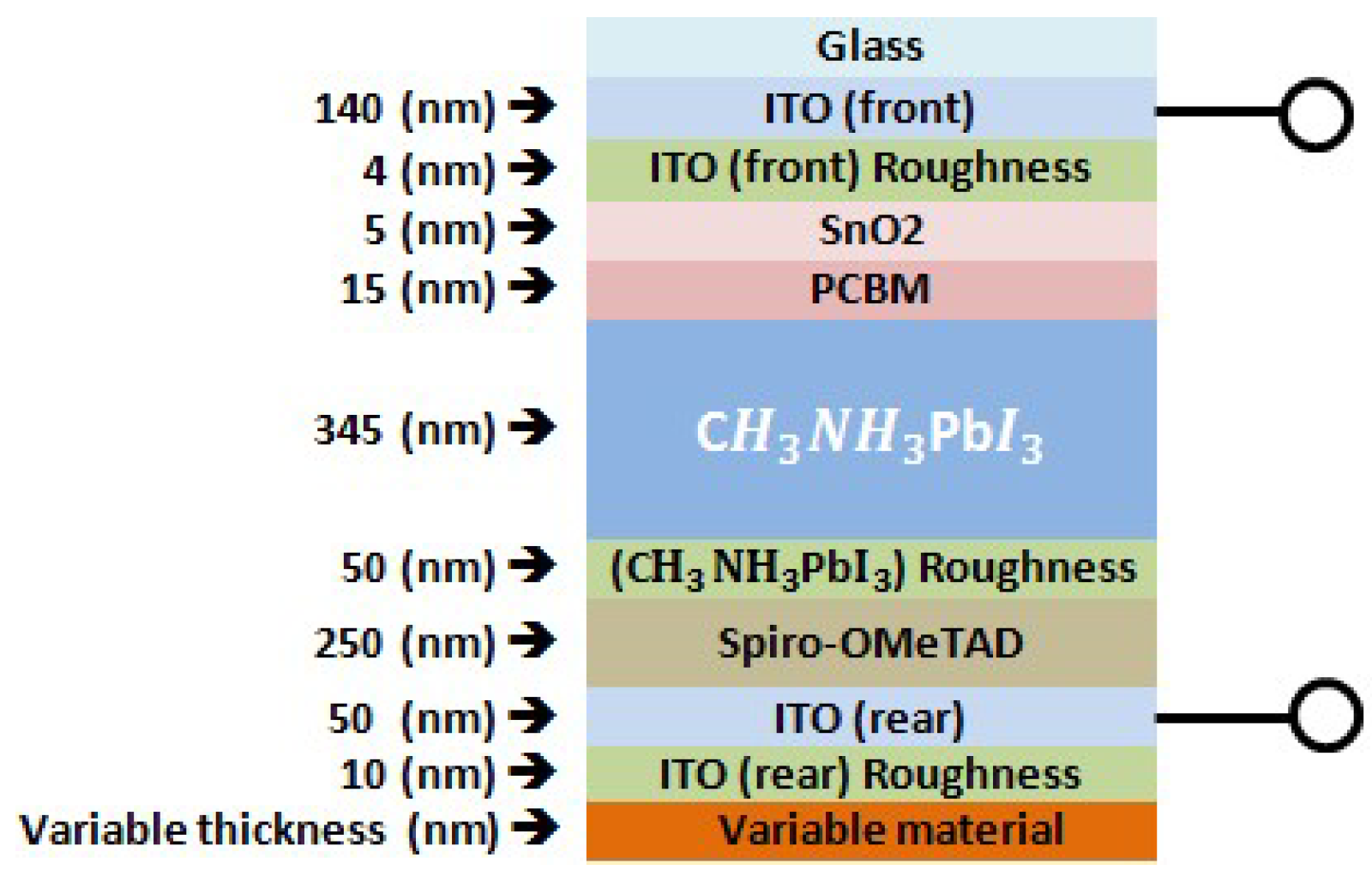

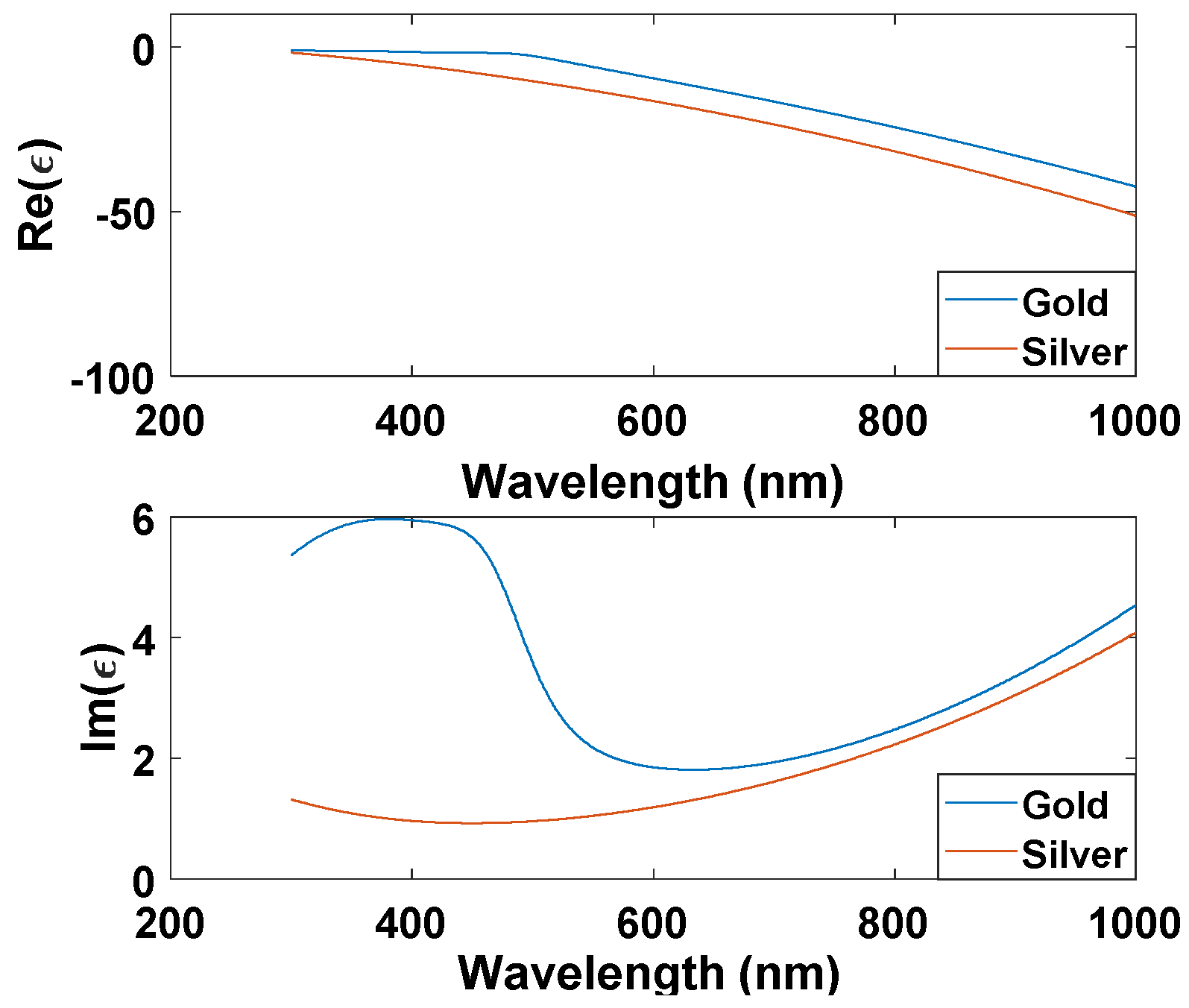
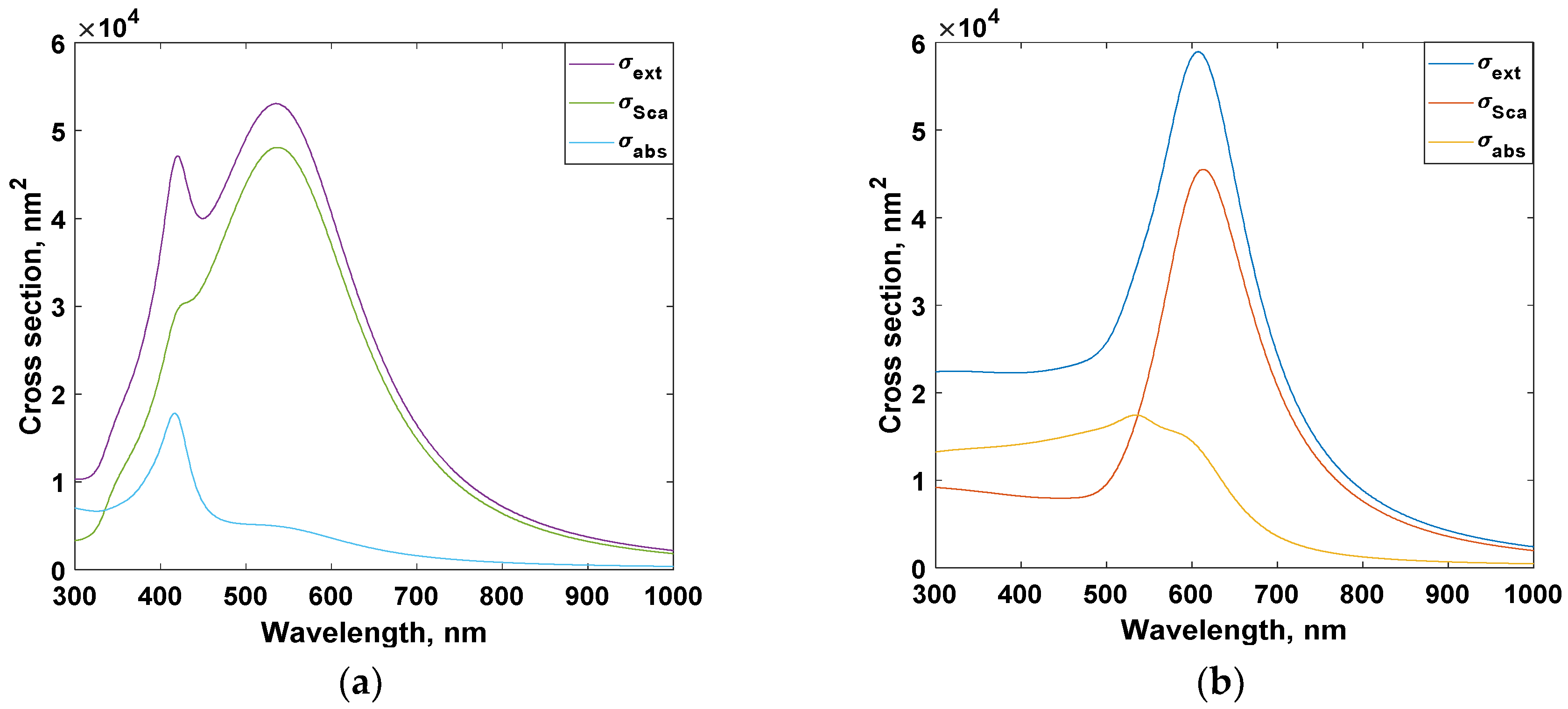
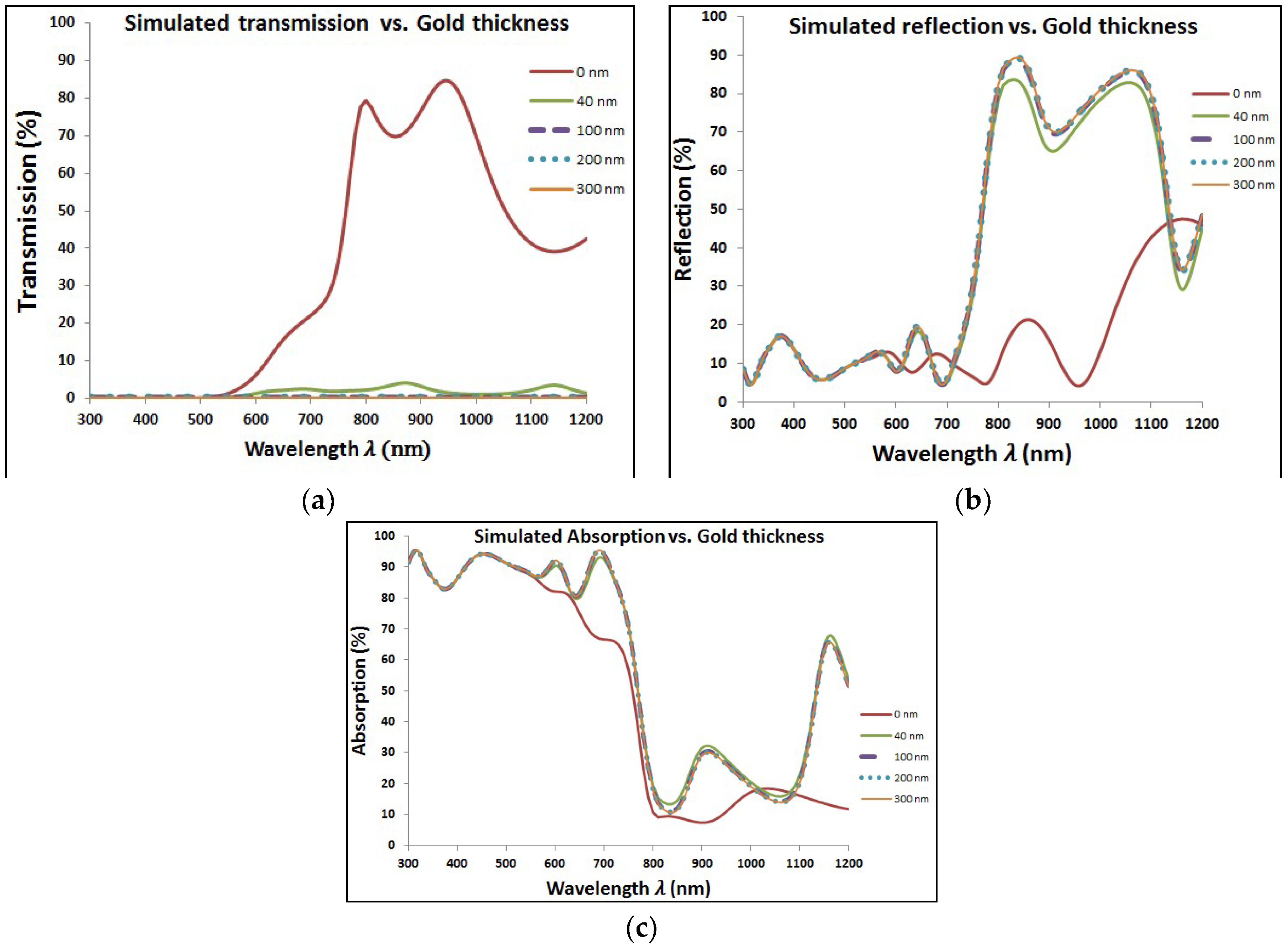
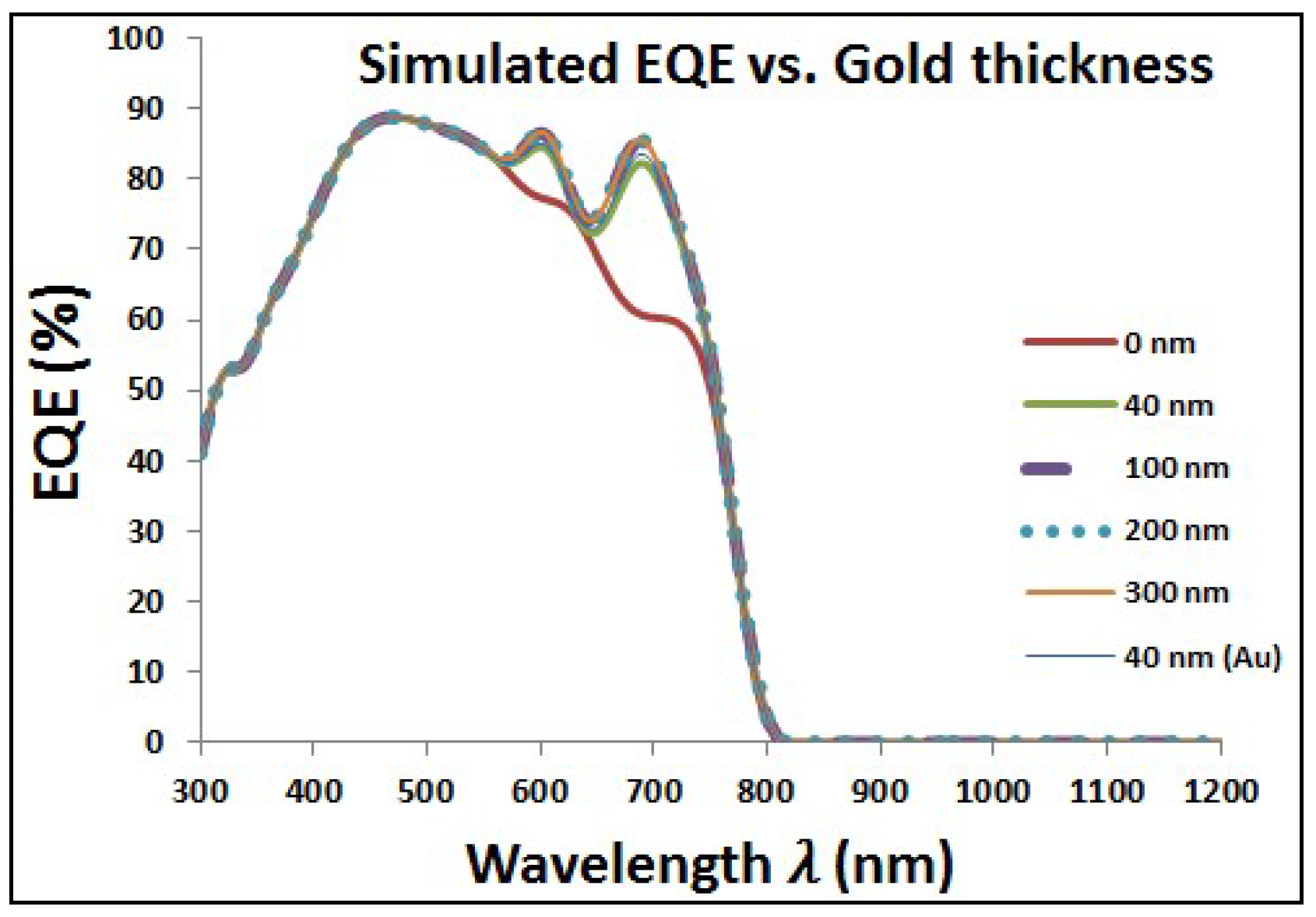
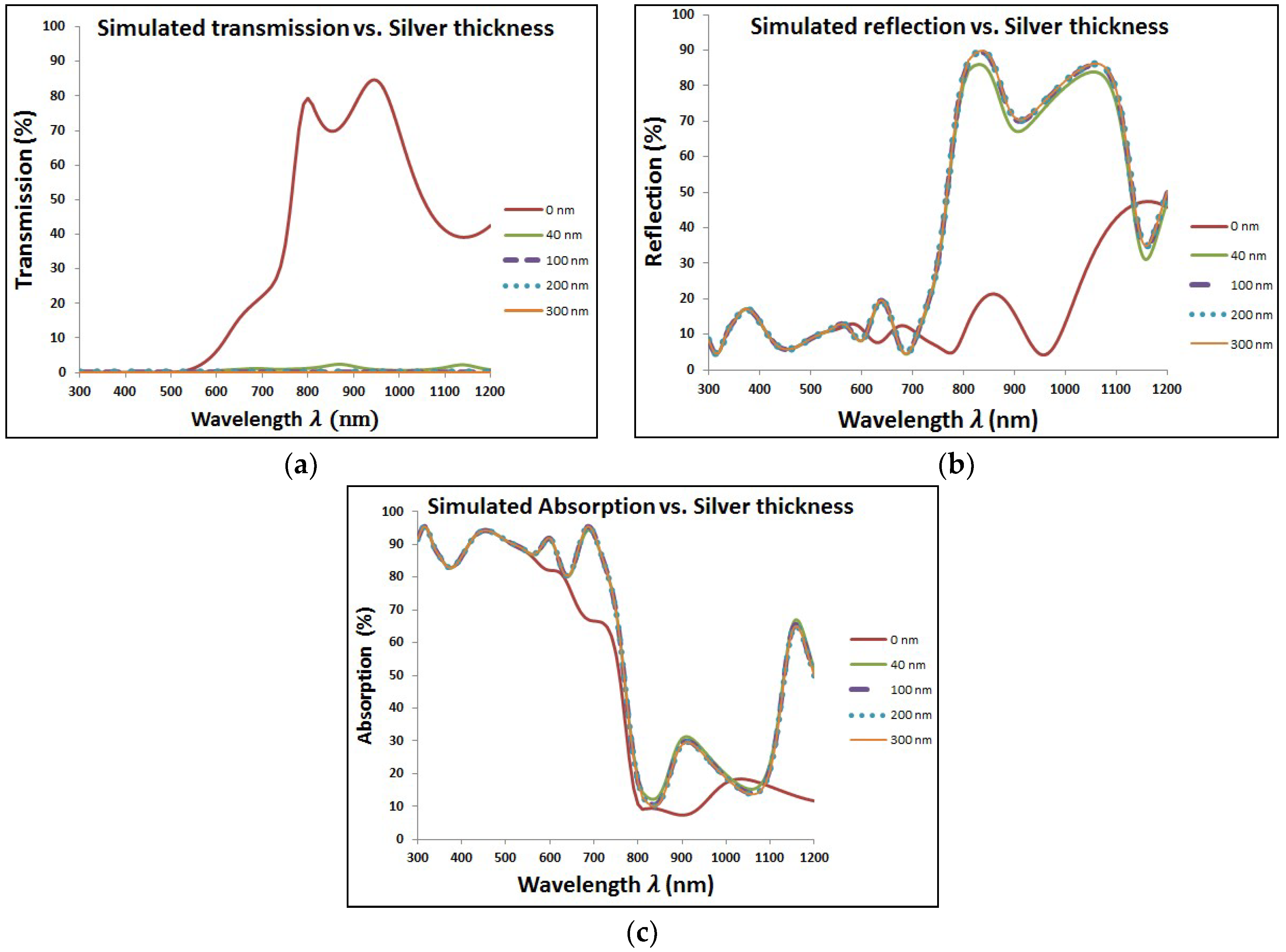


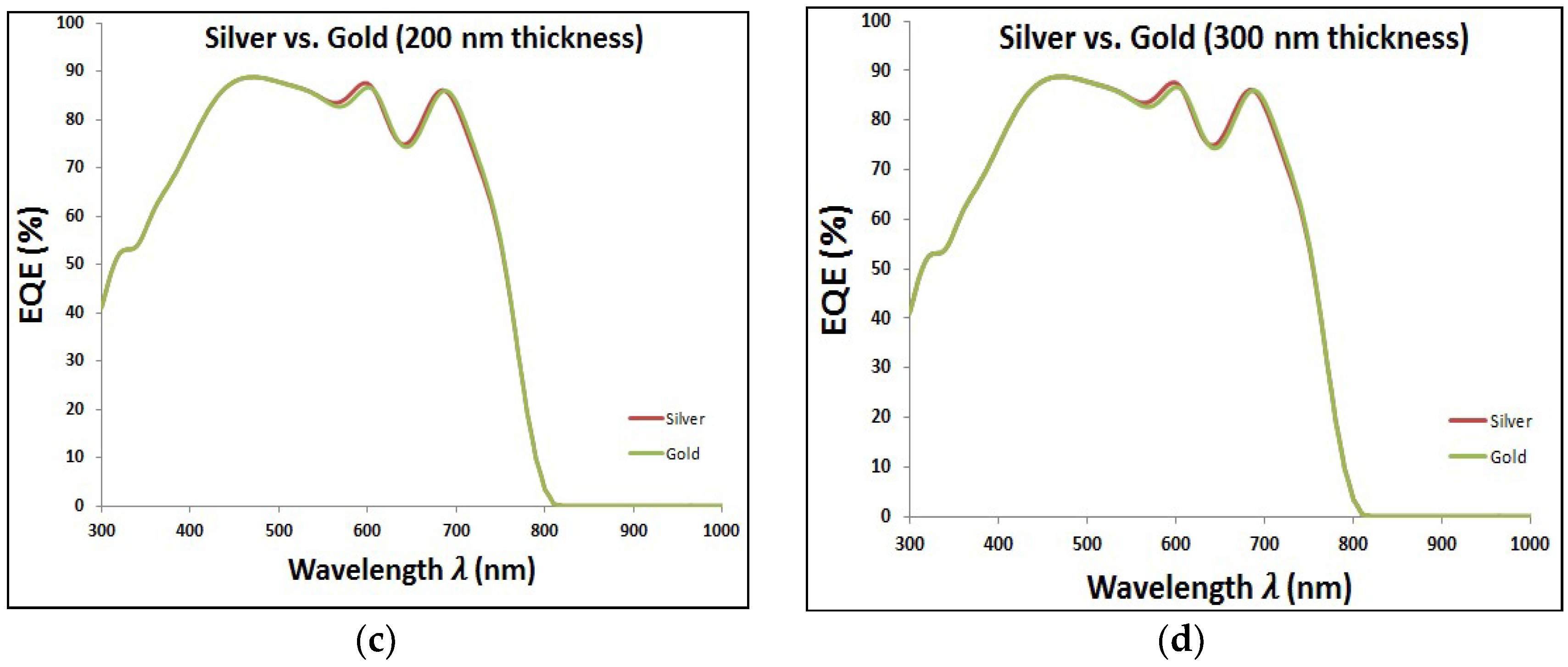
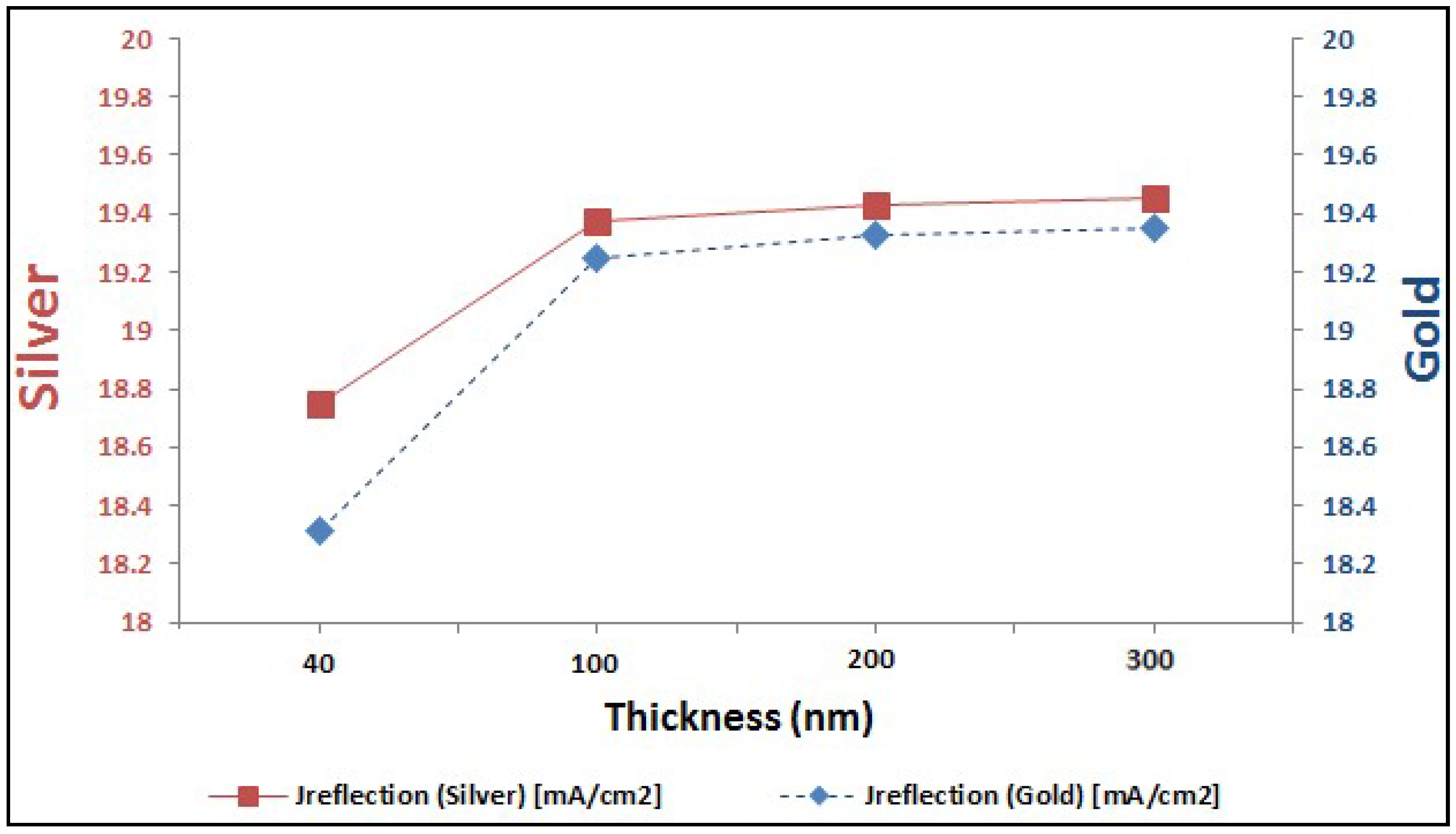
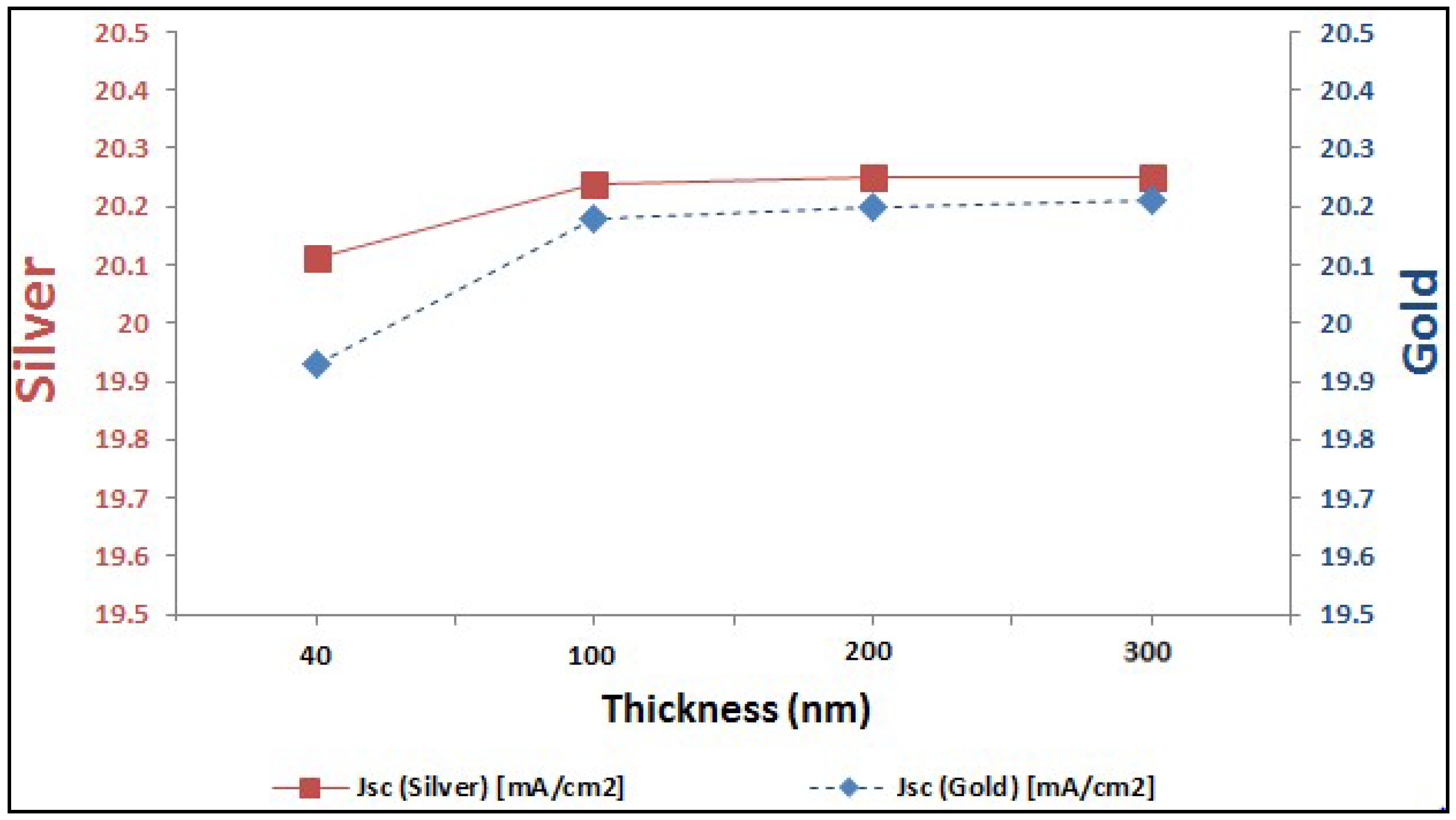
| A1 | A2 | |||||||||
|---|---|---|---|---|---|---|---|---|---|---|
| Au | 1.1431 | 1.3202 × 1016 | 0.2669 | 3.0834 | −1.2371 | −1.0968 | 3.8711 × 1015 | 4.1684 × 1015 | 4.4642 × 1014 | 2.3555 × 1015 |
| Ag | 15.833 | 1.3861 × 1016 | 1.0171 | 15.797 | −0.9394 | 1.8087 | 6.6327 × 1015 | 9.2726 × 1017 | 1.6666 × 1015 | 2.3716 × 1017 |
| Perovskite Cell Losses (mA/cm2) | ||||
|---|---|---|---|---|
| Gold (nm) | ||||
| 0 | 4.15 | 16.49 | 6.55 | 18.69 |
| 40 (Au) planar | 6.939 | 0.784 | 18.7 | 20.03 |
| 40 (Au NPs) | 7.45 | 0.764 | 18.31 | 19.93 |
| 100 (Au NPs) | 7.013 | 0.009 | 19.25 | 20.18 |
| 200 (Au NPs) | 6.926 | 0.000 | 19.33 | 20.20 |
| 300 (Au NPs) | 6.899 | 0.000 | 19.35 | 20.21 |
| Perovskite Cell Losses (mA/cm2) | ||||
|---|---|---|---|---|
| Silver (nm) | ||||
| 0 | 4.15 | 16.49 | 6.55 | 18.69 |
| 40 | 7.182 | 0.41 | 18.75 | 20.11 |
| 100 | 6.846 | 0.002 | 19.37 | 20.24 |
| 200 | 6.778 | 0.000 | 19.43 | 20.25 |
| 300 | 6.756 | 0.000 | 19.45 | 20.25 |
© 2018 by the authors. Licensee MDPI, Basel, Switzerland. This article is an open access article distributed under the terms and conditions of the Creative Commons Attribution (CC BY) license (http://creativecommons.org/licenses/by/4.0/).
Share and Cite
Hajjiah, A.; Kandas, I.; Shehata, N. Efficiency Enhancement of Perovskite Solar Cells with Plasmonic Nanoparticles: A Simulation Study. Materials 2018, 11, 1626. https://doi.org/10.3390/ma11091626
Hajjiah A, Kandas I, Shehata N. Efficiency Enhancement of Perovskite Solar Cells with Plasmonic Nanoparticles: A Simulation Study. Materials. 2018; 11(9):1626. https://doi.org/10.3390/ma11091626
Chicago/Turabian StyleHajjiah, Ali, Ishac Kandas, and Nader Shehata. 2018. "Efficiency Enhancement of Perovskite Solar Cells with Plasmonic Nanoparticles: A Simulation Study" Materials 11, no. 9: 1626. https://doi.org/10.3390/ma11091626





